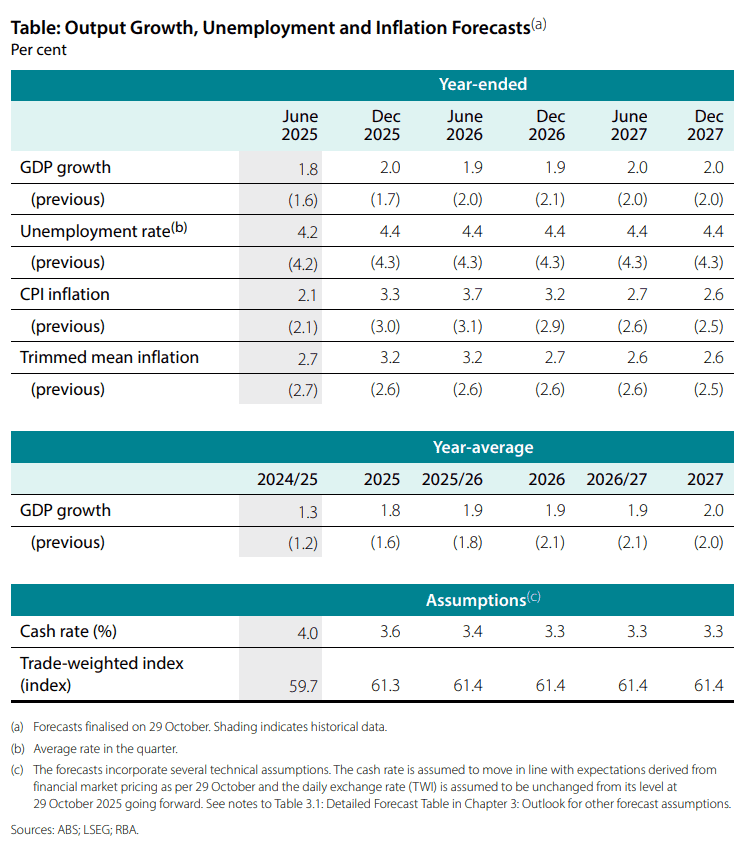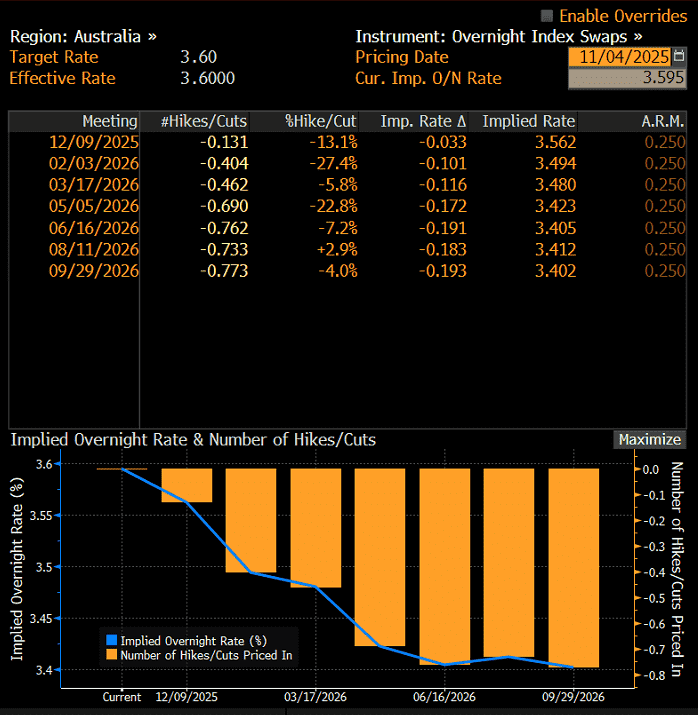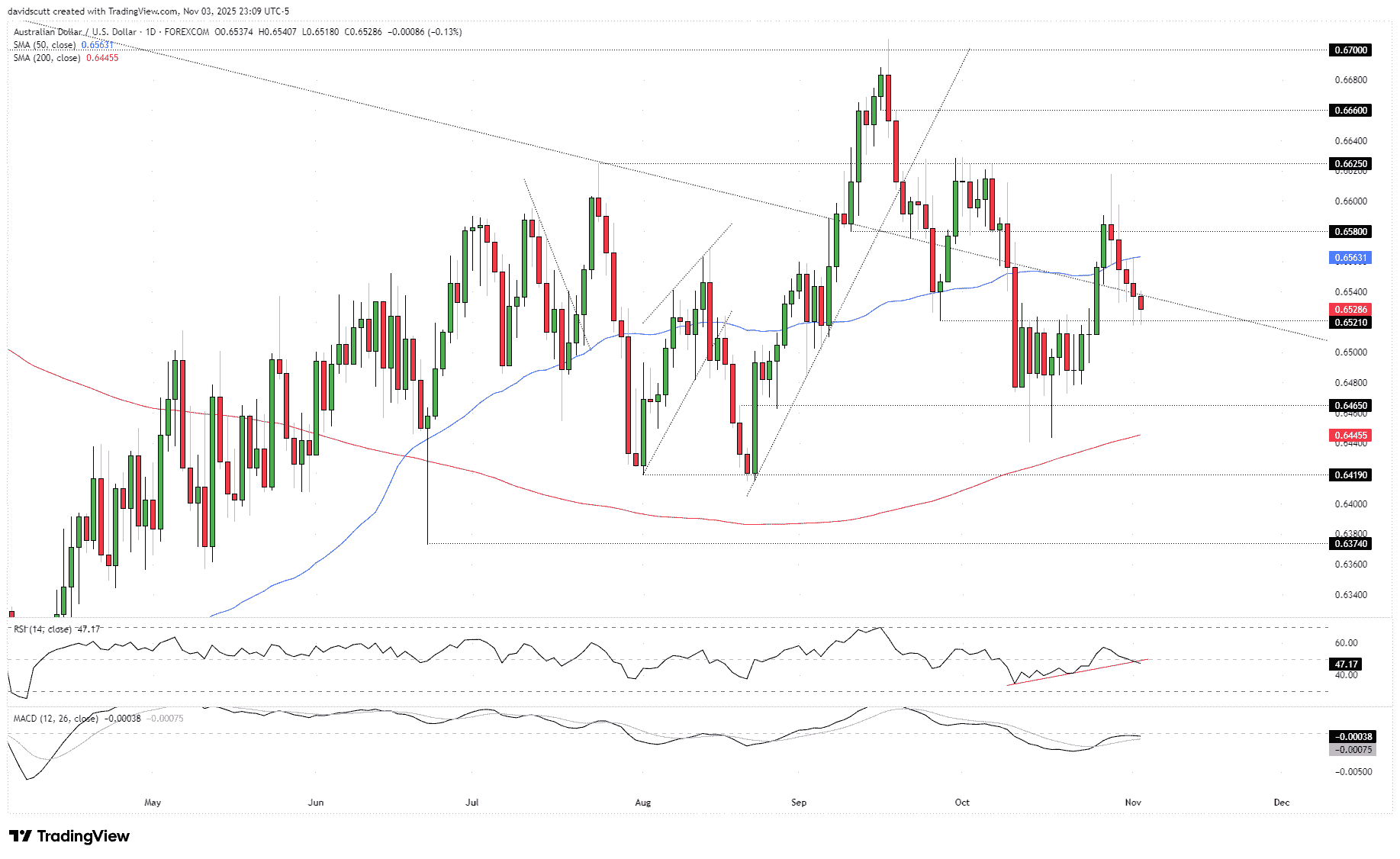BofA sees higher gold prices, likely to hit $5,000/oz in 2026
The RBA held rates at 3.6%, but its updated forecasts suggest the easing cycle may already be done. Are traders underestimating the hawkish tone?
- RBA left cash rate at 3.6%, as expected.
- Trimmed mean inflation is not back to 2.5% before 2027.
- Unemployment forecast steady at 4.4%, growth outlook solid.
- Swaps trim rate cut odds.
Summary
The RBA’s November decision was a hold, but not a dovish one. Updated forecasts show inflation staying above target for years, unemployment barely rising, and growth holding firm despite fewer cuts than previously assumed. Markets have pared back, easing expectations, and AUD/USD is probing key technical levels. With momentum signals neutral, price action will dictate the next move.
RBA Cash Rate May Have Bottomed
The RBA kept Australia’s cash rate steady at 3.6% in November, as widely expected by markets and economists. However, despite suggesting last week’s hot Q3 inflation report was in part driven by temporary factors, it does not see underlying inflation returning to the midpoint of its 2–3% target band by the end of 2027, pointing to the potential they may have already delivered the last rate cut for the cycle.
As this meeting coincides with the release of updated economic forecasts from the RBA, a lot of its commentary was devoted to the changes to the outlook for GDP growth, unemployment and inflation. The new update is found below.
Source: RBA
On the hotter-than-expected Q3 consumer price inflation report released last week, the RBA described it as “materially higher” than its prior forecasts. However, it noted “some of the increase in underlying inflation…was due to temporary factors.” Initially, markets took that line as being dovish, but that’s where the bank’s dovishness ended.
For a start, despite pointing to temporary factors partly driving the acceleration, its updated trimmed mean inflation profile does not have it returning to the 2.5% target before the end of 2027, deviating from the view presented three months earlier. And that was with two fewer rate cuts than what were factored in previously, a substantial hawkish recalibration that could have seen the RBA easily forecast it returning to the midpoint or even lower.
The RBA also refrained from forecasting a material increase in unemployment despite the shallower rate cut profile, pinning it at 4.4% out to the end of 2027, a tenth lower than the 4.5% level it sits today. Even its growth forecasts remained solid, with near-term expectations revised higher with only minor changes elsewhere. The RBA could have signalled growth risks from continued slightly restrictive policy settings but didn’t. That’s not dovish.
A Slightly Hawkish Hold
Considering trimmed mean inflation is not seen returning to the midpoint over the forecast horizon, and with little weakness seen in the labour market and economy, it hints the RBA may have already delivered its last rate cut for the cycle, even though one more was incorporated into the latest forecasts. That view is bolstered by its acknowledgement that “it will take some time to see the full effects of earlier cash rate reductions.”
It also repeated that labour market conditions “remain a little tight” with the recovery in household consumption “ongoing” and the housing market “continuing to strengthen.”
Given those statements, and considering what it could have forecast with the shallower rate cut profile, the broad assessment is this was a marginally hawkish hold from the RBA relative to market pricing.
Source: Bloomberg
Swaps agree at this stage with a minor hawkish recalibration across the AUD OIS curve, with a 25bp cut by September next year now priced at 77%, down from a touch over 80% beforehand.
AUD/USD Bounces from Support

Source: TradingView
After testing support at .6521 immediately following the RBA decision, AUD/USD has bounced to trade at .6529. Topside levels to consider when assessing setups include the 2021 downtrend around 10 pips higher, the 50-day moving average and .6625 resistance. Beneath .6521 support, .6465, and the 200-day moving average are the levels to watch.
There are signs emerging that the retreat in bearish momentum seen in recent weeks may be starting to turn again, although the overall message from RSI (14) and MACD is neutral when it comes to directional bias. Putting more emphasis on price signals is therefore warranted.
